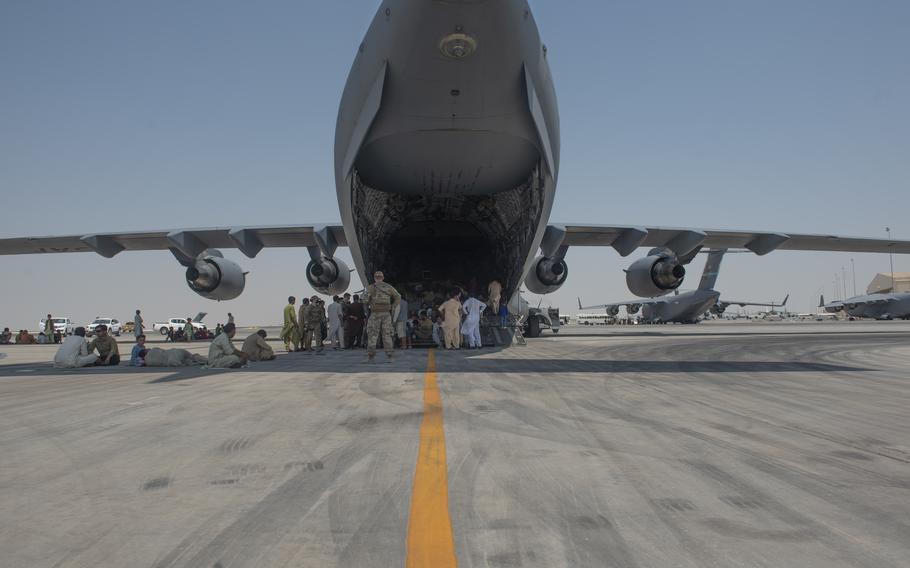
Evacuees wait under the wing of C-17 Globemaster lll after arriving in an undisclosed location in the Middle East region on Friday, Aug. 20, 2021, after being evacuated onboard a military aircraft from Hamid Karzai International Airport in Kabul, Afghanistan, as part of Operation Allies Refuge. (Kylie Barrow, U.S. Air Force)
WASHINGTON — U.S. military commanders have had to remove exhausted troops from work rotations to maintain safety as Kabul airlift crews on Monday flew the largest number of evacuation flights out of Afghanistan in a 24-hour period, the general who leads U.S. Transportation Command said Monday.
“I won't lie to you, [our crews] are tired — they're probably exhausted in some cases,” Army Gen. Stephen Lyons, the commander of TRANSCOM, told reporters at the Pentagon. “I know that the leaders from time to time are pulling crews out to make sure we don't have safety issues.”
Exhaustion has been well-documented as an operational risk hazard to troops in multiple recent studies on military fatigue, including in a 2018 study by the National Institute of Health and another published in June by the Naval Health Research Center.
Still, Lyons said air crews “are motivated, they are fired up and they are committed to complete this mission.”
It’s been less than two weeks since thousands of U.S. troops were deployed to Kabul airport to help evacuate thousands of Americans and Afghans seeking special immigrant visas to enter the United States. Though some evacuation efforts began in late July as the Aug. 31 deadline for U.S. forces to withdraw from Afghanistan loomed, most of its evacuations have occurred since Aug. 14 — the day before the Taliban captured Kabul, Afghanistan’s capital city.
The U.S. on Monday achieved its largest number of airlifts out of Afghanistan in a single day since evacuations started, with 16,000 people leaving Kabul on 25 C-17 and three C-130 military transport aircraft and 61 commercial flights within the past 24 hours, said Army Maj. Gen. Hank Taylor, the Joint Staff’s deputy director for regional operations. All but 5,000 of the evacuees were taken on the military aircraft.
In total, the U.S. has evacuated about 37,000 people from Kabul since Aug. 14, and 42,000 since July, according to the Pentagon.
To sustain and improve that pace, crews are working constantly to move out evacuees as the clock ticks on the Aug. 31 deadline, Lyons said.
While President Joe Biden has not dismissed the idea of extending evacuation operations past Aug. 31, Taliban spokesman Suhail Shaheen said Monday that the group “will not allow America's military presence in Afghanistan after the end of August.”
To accomplish the task, Lyons said he has “twice as many crews” as there are military aircraft assisting in the evacuation, though rotating those forces is not always possible.
“The idea is to keep those planes moving all the time, either by extending the crew day or preferably by swapping crews and keeping the iron in motion,” Lyons said. “There’s a very tight detail management system to do that.”
Additionally, TRANSCOM is aiming to keep the on-the-ground time in Afghanistan to less than an hour as troops help load evacuees onto the aircraft, he said.
“The faster we can turn — either load or discharge — the faster we can turn that aircraft,” Lyons said. “We're razor-focused on bringing down … the time on the ground to under an hour.”
Even with the quick turnarounds, Lyons said the military is working to optimize the amount of people evacuated on each flight, filling each aircraft with between 400-450 passengers per flight.
“The idea is we'd never want to leave Kabul airport [with] an empty plane or even a partially full plane if we can avoid it,” he said.
Despite the grueling pace, Lyons said TRANSCOM is committed to continuing the evacuation efforts for as long as they are asked to do so.
“Full accelerator, we’re not going to let up,” he said. “As long as there’s a mission to be accomplished, we’ll be out there.”